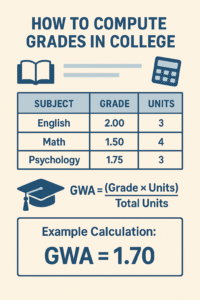Free GWA Calculator Philippines 2025: Calculate Your General Weighted Average Easily
Are you a Filipino student looking to calculate your General Weighted Average (GWA) for college, Pisay, or high school? This free GWA Calculator Philippines 2025 guide is designed just for you. Whether you want to check if you qualify for Latin honors, maintain scholarship eligibility, or simply monitor your academic performance, understanding how to compute your GWA is essential. In this article, we will explain the significance of GWA, how to calculate it manually and online, discuss grading systems in the Philippines, and provide useful tools like online calculators and converters.
What is a GWA Calculator and Why Is It Important?
A GWA calculator is a tool that helps students compute their General Weighted Average based on their grades and the number of units per subject. Unlike a simple average, the GWA gives more weight to subjects with higher unit values, reflecting your overall academic performance more accurately.
In the Philippines, the GWA is widely used by colleges and universities as the standard metric to evaluate a student’s academic standing. It helps determine scholarship eligibility, honor classifications like Magna Cum Laude, and minimum grade requirements for courses or programs.
Using a general weighted average calculator can simplify the process. free GWA calculator simplifies this process by allowing students to input their grades and units quickly and get an accurate result without manual calculations.
How Do You Compute Your General Weighted Average (GWA)?
To calculate your GWA, follow these steps:
- List all your subjects with their respective grades.
- Note the number of units each subject carries when you calculate the GWA.
- Multiply each grade by its corresponding units to get the weighted grade.
- Add all weighted grades together.
- Divide the total weighted grade by the total number of units.

Learn how to compute your general weighted average. (GWA) in the philippines
Formula:
GWA=∑(Grade×Units)∑Units\text{GWA} = \frac{\sum (\text{Grade} \times \text{Units})}{\sum \text{Units}}
Example:
| Subject | Grade | Units | Weighted (Grade × Units) |
|---|---|---|---|
| Science | 1.50 | 4 | 6.00 |
| PE | 2.00 | 2 | 4.00 |
| Filipino | 1.75 | 3 | 5.25 |
Total Units = 9
Total Weighted Grades = 6 + 4 + 5.25 = 15.25
GWA = 15.25 ÷ 9 = 1.69
This method applies whether you are a high school student, college student, or in specialized schools like Pisay.
What Is the Philippine Grading System for GWA Computation?
Most colleges in the Philippines use a numeric grading scale from 1.00 (highest) to 5.00 (lowest) as recommended by CHED (Commission on Higher Education). Some schools also use percentage grades that can be converted into this numeric scale.
| Grade | Percentage Range | Remarks |
|---|---|---|
| 1.00 | 97%-100% | Excellent |
| 1.25 | 94%-96% | Very Good |
| 1.50 | 91%-93% | Very Good |
| 1.75 | 88%-90% | Good |
| 2.00 | 85%-87% | Good |
| 2.25 | 82%-84% | Satisfactory |
| 2.50 | 79%-81% | Satisfactory |
| 2.75 | 76%-78% | Fair |
| 3.00 | 75% | Passed |
| 5.00 | Below 75% | Failed |
Different universities like UST or RTU may use percentage-based grading but convert it internally to this scale for GWA computation.
How to Use an Online GWA Calculator Philippines 2025
Online tools make GWA computation faster and more accurate. Here’s how to use an GWA calculator:
- Enter your grades for each subject.
- Input the corresponding number of units.
- The calculator automatically multiplies grades by units.
- It sums up all weighted grades and divides by total units.
- The result shows your calculated GWA instantly.
These calculators are compatible with numeric grades (1.0–5.0) and percentage grades (50%–100%). The GWA calculator Philippines 2025 is updated to meet current CHED guidelines and is free to use.
Can You Calculate GWA Using Percentage Grades?
Yes! Many schools use percentage grades rather than numeric values directly. You can convert these percentages into the Philippine numeric grading scale before using the calculator.
For example:
- A grade of 95% corresponds roughly to a GWA of 1.00 – 1.25
- A grade of 88% corresponds roughly to a GWA of 1.75 – 2.00
- A grade of 80% corresponds roughly to a GWA of 2.25 – 2.50
Use a GWA to percentage calculator or conversion chart to convert your raw scores first, then proceed with the usual weighted average formula.
What Are the Different Honor Classifications Based on GWA?
Honor classifications motivate students to maintain excellent academic performance and are often required for scholarships or graduation honors.
| GWA Range | Honor |
|---|---|
| 1.00 – 1.20 | Summa Cum Laude |
| 1.21 – 1.45 | Magna Cum Laude |
| 1.46 – 1.75 | Cum Laude |
| Above 1.75 | No Latin Honor |
These classifications vary slightly by institution, so always verify with your registrar or department.
How Does the University of the Philippines Calculate GWA?

UP Diliman uses a numeric scale from 1.00 (highest) to 5.00 (lowest) following CHED standards.
Example:
| Subject | Grade | Units |
|---|---|---|
| GE Elective | 1.25 | 3 |
| Major | 1.50 | 4 |
| PE | 2.00 | 2 |
GWA = (1.25×3)+(1.5×4)+(2×2)9=3.75+6+49=13.759=1.53\frac{(1.25 \times 3) + (1.5 \times 4) + (2 \times 2)}{9} = \frac{3.75 +6 +4}{9} = \frac{13.75}{9} = \mathbf{1.53}
This example shows how different subjects with varying units impact your overall GWA.
How to Convert Your GWA to GPA or Percentage
Filipino students sometimes need to convert their GWA into other formats like US GPA or percentages for applications abroad or certain scholarships.

Approximate Conversion Table:
| GWA | Approximate US GPA | Estimated Percentage can help you compute GWA effectively. |
|---|---|---|
| 1.00 | 4.0 | ~97-100% |
| 1.25 | 3.9 | ~94-96% |
| 1.50 | 3.7 | ~91-93% |
| 1.75 | 3.5 | ~88-90% |
| 2.00 | 3.0 | ~85-87% |
Use our GWA to GPA converter or GWA to percentage calculator for detailed conversions tailored to your exact grade.
What Is Special About the Pisay GWA Calculator?
The Philippine Science High School (Pisay) uses a grading system focused on performance and research outputs but still allows conversion into a CHED-compatible numeric scale.
Students can use our dedicated Pisay GWA calculator which converts Pisay grades into standard numeric grades before computing the final GWA using the same formula:
GWA=∑(Grade×Units)∑Units\text{GWA} = \frac{\sum (\text{Grade} \times \text{Units})}{\sum \text{Units}}
This tool helps Pisay students monitor their academic standing aligned with national standards.
Tips to Boost Your GWA and Maintain Good Academic Standing
- Prioritize high-unit subjects: Since these have more weight, excelling here improves your overall GWA faster.
- Stay consistent: Aim for at least a A good GWA of around 1.75 or lower is often necessary for scholarships at universities in the Philippines..
- Use online tools: An online GWA calculator can help you track progress every semester.
- Understand grading policies: Know how your school converts percentages or uses different scales to compute the GWA.
- Seek help early: If you’re struggling in any subject, seek tutoring before it impacts your GWA drastically.
- Plan your courses: Balance difficult subjects with easier ones if possible.
Frequently Asked Questions About GWA Calculation
Q: What is considered a good GWA in the Philippines?
A: In the Philippines, a GWA of 1.75 or lower is generally considered good and meets the minimum GWA requirement for many scholarships and academic recognitions. A GWA of 1.25 or better is often regarded as a high GWA, indicating excellent academic performance. The significance of GWA lies in how it reflects a student’s GWA based on their academic performance. overall academic performance during their studies.
Q: Can I compute my GWA manually without a calculator?
A: Yes, you can manually calculate your general weighted average by multiplying each grade by its corresponding unit or credit load, then summing these values to get the grade weighted average. Finally, divide this total by the sum of all units. This straightforward method of GWA computation is the foundation of how GWA is calculated in most institutions in the Philippines, the GWA is a crucial metric used in the Philippines.
Q: Is this calculator accepted by CHED or universities like UP or Pisay?
A: The GWA calculator Philippines and similar tools follow the Philippines grading system, which is widely used in the Philippines including institutions like the University of the Philippines grading system and GWA calculator Pisay. However, always verify with your own school since some universities may have specific rules. The calculator is compatible with both online and offline use.
Q: Can I use percentage grades directly to compute my GWA?
A: No, you cannot directly use percentage grades. You need to first convert these percentages to numeric grades using a GWA to percentage conversion chart provided by your school. Some tools like an online GWA computation tool or a GWA to percentage calculator can help with this conversion before you proceed to compute your GWA.
Q: Does this work for regional universities like RTU or Bicol University?
A: Yes, as long as these institutions follow the system used in the Philippines for the computation of your GWA., you can use this method or an GWA calculator Philippines to compute your GWA. Whether you want to calculate GWA in college, over multiple semesters (GWA for multiple semesters), or for a single term, these calculators and methods are applicable across most colleges in the Philippines.
Additional Information
- You can find a free online GWA calculator or download an offline GWA calculator for convenience.
- Some calculators even allow you to convert your GWA to GPA using a GWA to GPA converter, helping students understand their performance in different grading systems.
- The GWA calculator website can assist you in calculating the GWA accurately. provides step-by-step instructions and examples on how to compute your GWA, ensuring you accurately determine your student’s overall GWA.
- Tools like a GWA calculator in Excel can also be used for more customized calculations, especially if you want to track your grades over multiple semesters.
- Using the GWA calculator makes it easier to understand how your grades translate into your academic standing and helps you plan how to boost your GWA if needed.
Why Is Knowing Your GWA Important?
The importance of GWA stems from its role as a key metric for scholarships, academic honors, and graduation eligibility in the Philippines. Since your GWA is computed as an average weighted by course units, it accurately reflects not just your grades but also the difficulty and credit load of your courses, which are essential for the computation of your GWA. Institutions use this metric to assess overall student performance consistently.
If you want to try it yourself, use our GWA calculator, which is free to use, easy to navigate, and designed specifically for students in the Philippines. Whether you’re a high school student transitioning to college or already studying at a university, this tool will help you understand your academic standing clearly.
Summary: Key Points to Remember About Your GWA Calculator
- The General Weighted Average (GWA) reflects overall academic performance weighted by units.
- Use the formula: GWA=∑(Grade×Units)∑Units\text{GWA} = \frac{\sum (\text{Grade} \times \text{Units})}{\sum \text{Units}}
- Philippine grading scale ranges from 1.00 (excellent) to 5.00 (failed).
- Different schools may use percentage grades convertible to numeric grades.
- Online tools like the free GWA calculator Philippines make computation fast and accurate.
- Honor classifications depend on your final GWA (Summa, Magna, Cum Laude).
- Pisay has a unique system but can be converted using specialized calculators.
- Converting GWA to GPA or percentage is possible with conversion tables or online converters.
- Maintaining a good GWA helps secure scholarships and academic honors.
- Always verify specific rules with your university or school registrar.
